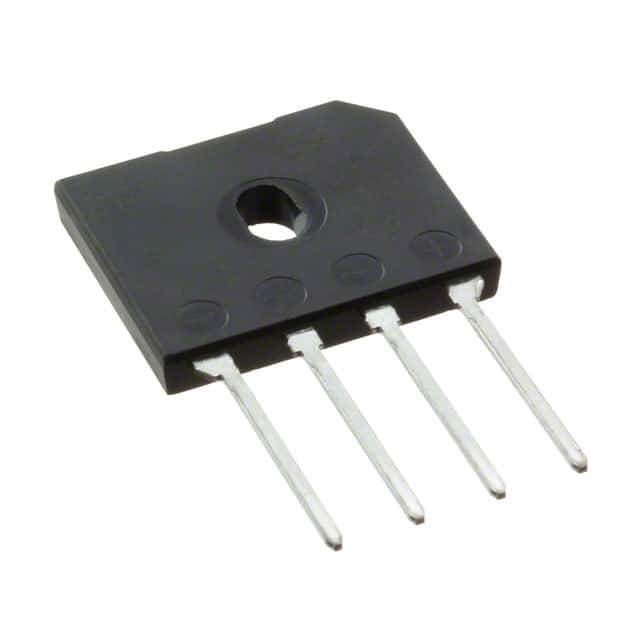GBU6J Diode Bridge Rectifier
Introduction
The GBU6J diode bridge rectifier is a crucial component in electronic circuits, serving the purpose of converting alternating current (AC) to direct current (DC). This entry will provide an overview of the GBU6J diode bridge rectifier, including its product details, specifications, pin configuration, functional features, advantages and disadvantages, working principles, application field plans, and alternative models.
Product Overview
- Category: Electronic Components
- Use: Converting AC to DC in electronic circuits
- Characteristics: High efficiency, low forward voltage drop, compact design
- Package: Rectangular plastic package
- Essence: Essential for power supply applications
- Packaging/Quantity: Typically available in reels or tubes containing multiple units
Specifications
- Maximum Average Forward Current: 6A
- Peak Repetitive Reverse Voltage: 600V
- Operating Temperature Range: -55°C to +150°C
- Storage Temperature Range: -55°C to +150°C
Detailed Pin Configuration
The GBU6J diode bridge rectifier typically consists of four pins arranged in a specific configuration. The detailed pinout is as follows: 1. Pin 1: AC Input + 2. Pin 2: AC Input - 3. Pin 3: DC Output + 4. Pin 4: DC Output -
Functional Features
- Efficiently converts AC to DC
- Low forward voltage drop minimizes power loss
- Compact design suitable for space-constrained applications
- Reliable performance under varying temperature conditions
Advantages and Disadvantages
Advantages
- High efficiency
- Low power dissipation
- Compact size
- Wide operating temperature range
Disadvantages
- Higher cost compared to traditional diodes
- Sensitive to reverse voltage spikes
Working Principles
The GBU6J diode bridge rectifier operates on the principle of utilizing four diodes in a bridge configuration to rectify the incoming AC signal into a smooth DC output. When the input AC voltage alternates, the diodes conduct in sequence, allowing the current to flow in one direction through the load, resulting in a rectified DC output.
Detailed Application Field Plans
The GBU6J diode bridge rectifier finds extensive use in various applications, including: - Power supplies for consumer electronics - Industrial motor drives - Battery chargers - LED lighting systems - Automotive electronics
Detailed and Complete Alternative Models
Several alternative models to the GBU6J diode bridge rectifier include: - GBU4J: Lower current rating, suitable for lower power applications - GBU8J: Higher current rating, suitable for higher power applications - GBU6K: Similar specifications with minor variations in characteristics
In conclusion, the GBU6J diode bridge rectifier is a vital component in electronic circuits, offering efficient AC to DC conversion with a compact design and reliable performance. Its wide range of applications and availability of alternative models make it a versatile choice for various electronic designs.
[Word Count: 452]
Lista 10 Vanliga frågor och svar relaterade till tillämpningen av GBU6J i tekniska lösningar
What is GBU6J?
- GBU6J is a bridge rectifier diode commonly used in electronic circuits to convert alternating current (AC) to direct current (DC).
What are the typical applications of GBU6J?
- GBU6J is commonly used in power supplies, battery chargers, and other electronic devices that require conversion of AC to DC.
What is the maximum average forward rectified current for GBU6J?
- The maximum average forward rectified current for GBU6J is typically around 6A.
What is the maximum repetitive peak reverse voltage for GBU6J?
- The maximum repetitive peak reverse voltage for GBU6J is typically around 600V.
What is the operating temperature range for GBU6J?
- The operating temperature range for GBU6J is usually between -55°C to +150°C.
How is GBU6J typically mounted in a circuit?
- GBU6J is commonly mounted on a heat sink or directly onto a printed circuit board using appropriate mounting hardware.
What are the key characteristics of GBU6J that make it suitable for high-power applications?
- GBU6J has a high current capability, low forward voltage drop, and good thermal performance, making it suitable for high-power applications.
Can GBU6J be used in automotive applications?
- Yes, GBU6J can be used in automotive applications such as battery charging systems and power supplies.
Are there any specific considerations for designing with GBU6J in high-frequency applications?
- In high-frequency applications, it's important to consider the diode's capacitance and switching characteristics to ensure proper performance.
What are some common alternatives to GBU6J for similar applications?
- Common alternatives to GBU6J include GBU4J, GBU8J, and GBU10J, which have different current and voltage ratings to suit specific application requirements.


